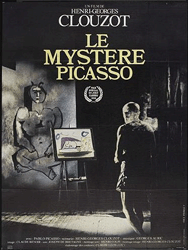Henri-Georges Clouzot
 Beginning last Thursday, the TIFF Bell Lightbox began their retrospective on French director Henri-Georges Clouzot, best–known for his classic double-crossing mystery Diabolique (1955) and the men transporting a deadly cargo across terrible terrain in Wages of Fear (1953).
Beginning last Thursday, the TIFF Bell Lightbox began their retrospective on French director Henri-Georges Clouzot, best–known for his classic double-crossing mystery Diabolique (1955) and the men transporting a deadly cargo across terrible terrain in Wages of Fear (1953).
Long regarded as one of France’s master filmmakers, there’s a whole canon of work that’s on DVD, and other titles yet to appear on home video, but even those on DVD and Blu-ray still can’t hold up to the experience of seeing a major work on the big screen.
What people choose to see is sometimes based on personal quirks, and within my own preferences, my taste focused on The Mystery of Picasso (1956). Once unavailable anywhere, it was brought back into distribution during the 1980s, and eventually made its way to Pay TV and home video.
The current DVD release is 11 years old, and it’s a non-anamorphic transfer that can’t quite match up seeing the film in straight 35mm, because there’s that last reel where the ratio pops from standard 1.33:1 to wide CinemaScope 2.35:1. The downside to the current print (which seems to date from ’82 or ’86) is the shrillness that affects Georges Auric’s high brass, but that’s more a case where the film ought to be given a restoration so it’s not only up to par with current cinemas, but ready for a HD transfer for Blu-ray. That, and Auric’s own style which can be sonically aggressive.
The basic concept of Clouzot’s film is simple: capture the artist as he begins a series of sketches and paintings, as though each stroke occurs on a blank film canvas. Using special paper and inks that bleed through to the other side where Claude Renoir’s camera was positioned, Picasso does more than create art. He creates ideas that flow between a mood or story in flux, or as the artist himself tells the director, he wants the audience to see the total story at work.
Dramatic becomes playful when Picasso sketches what resembles a handful of bugs, which in turn become a rooster, and then expands into a fish with a rooster-like pattern. Picasso keeps challenging audience expectations as he plays with his graphics, and Clouzot similarly uses the camera to hyper-compact the creative process into something cinematically efficient: in one case, what flows in less than a few minutes took 5 hours to paint.
In-camera editing creates fluctuating stages, whereas reverse montages show how pre-laid geometric patterns become a panorama of characters, and revert back to their original, simple geometry – a trick that cleanly demonstrates the complexity of Picasso’s mindset.
The colours in the 35mm print aren’t blazingly vibrant, but the camera and film stock capture the contrasts as Picasso begins to add colour, first as dots, patterns, X’s, and integrate every component into a boudoir, or a matador. Bullfighting is a major component, and the most startling is a matador in mid-toss, sprawled in shock over the bull’s back after being knocked off his feet.
Picasso alternates the shading in a continuous flow, and while it sounds like a trivial detail to describe, onscreen it’s part of a painting’s evolution, and the artist figuring out what he likes, and what doesn’t work.
The film’s finale – in ‘scope – consists of a seaside resort which flows from line drawings to colour painting, then collage, after which Picasso explains ‘it’s not going well,’ and warns the director (and audience) ‘it will get worse.’ Erasing unworkable ideas or wrong turns, he starts again, and reconfigures core elements intp new formations before literally signing off, and walking away from the camera into a grainy blue darkness.
It’s surprising there haven’t been any major imitations of Clouzot’s film, but perhaps it’s due to the film’s tough availability, audience awareness, or interest in such an unusually conceptualized film. Two people walked out during the screening this past Sunday, perhaps because they were wholly unaware of its content and narrative structure.
Mystery of Picasso is straightforward, but its simplicity of presentation – painting on film, so to speak – may feel a bit oppressive for some; or those simply not in the mood to see birthed art underscored with Auric’s music.
The film screens again Tuesday October 25th at 8:45pm, and at 78 mins., it’s a perfect gem. (See sample trailer on YouTube.)
Films in this series not available on home video (in North America) include The Murderer Lives at 21 (1942) +La Terreur de Batignolles (1931), Oct. 27: Manon (1949) [read review at KQEK.com], Nov. 8: Miquette et sa mere (1950), Nov. 10: La Prisonnière (1968), Nov. 15: La Vérité (1960), and Nov. 24: Les Espions (1958).
.
.
Mark R. Hasan, Editor
KQEK.com ( Main Site / Mobile Site )
Category: EDITOR'S BLOG, FILM REVIEWS





Connect
Connect with us on the following social media platforms.